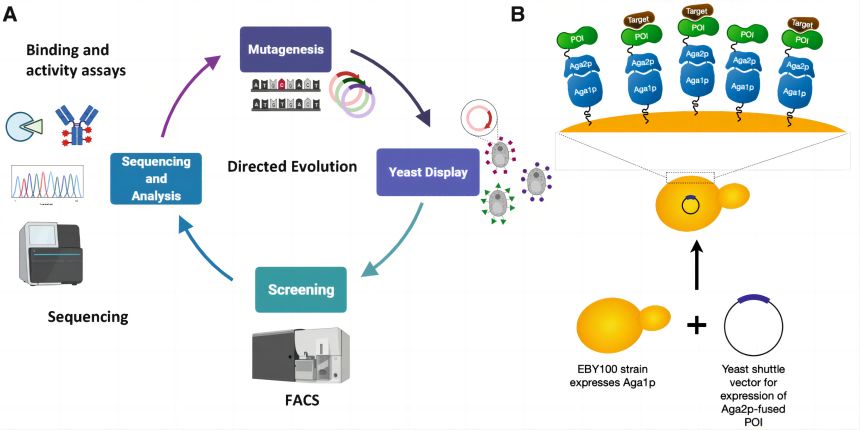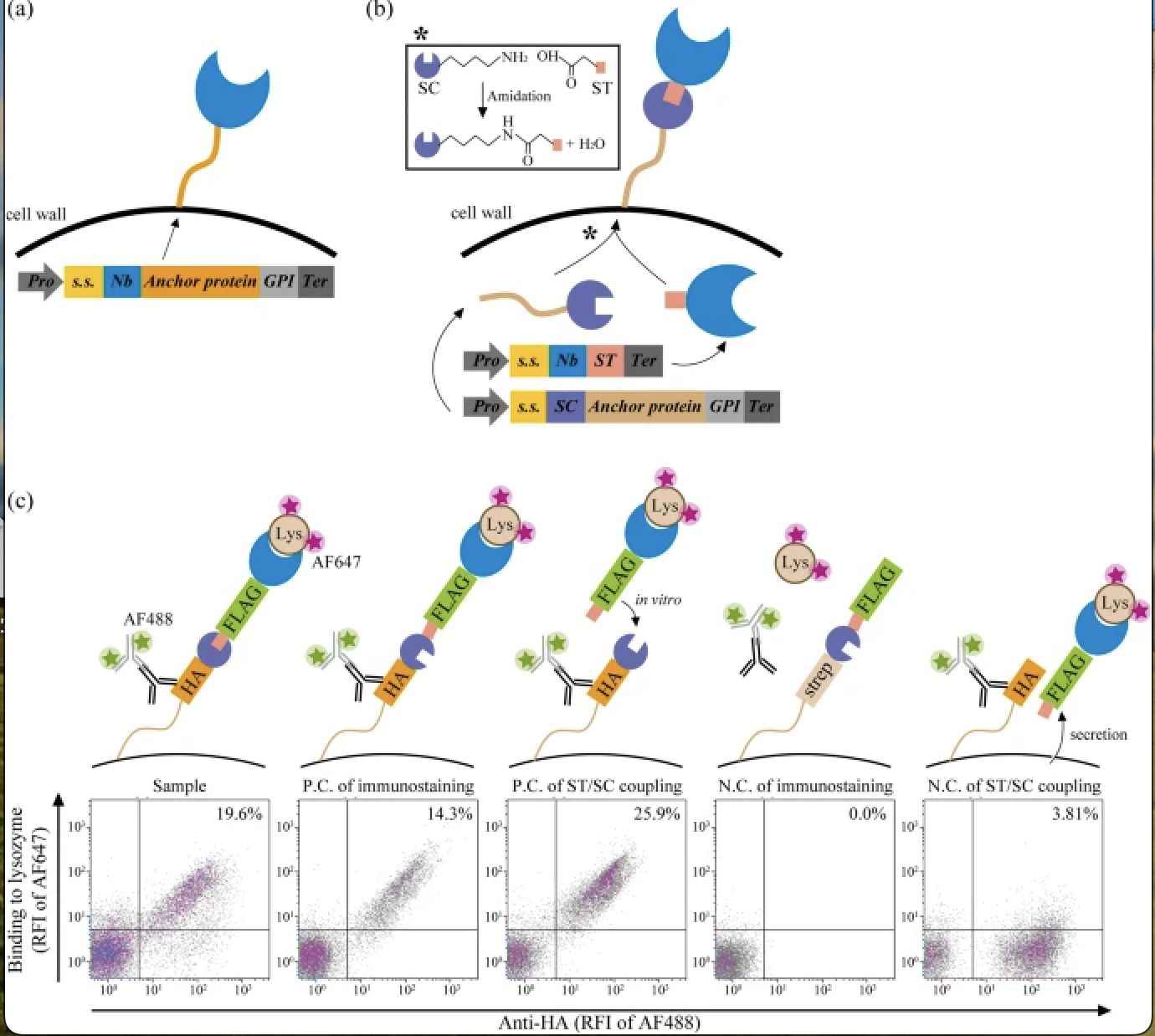Yeast Surface Display-based Enzyme Directed Evolution is a cutting-edge technology that allows the modification and improvement of enzyme properties. This technique opens up a new world of possibilities for bioengineering by allowing us to customize enzymes to increase their catalytic efficiency, enhance their stability, and alter their substrate specificity, among other things. This technological advancement is making significant strides in a wide array of sectors, including drug discovery, the production of biofuels, and industrial biocatalysis.
 Yeast Surface Display-based Enzyme Directed Evolution (Maryam R. and Eric T. B., 2022)
Yeast Surface Display-based Enzyme Directed Evolution (Maryam R. and Eric T. B., 2022)
Service Process
Our Yeast Surface Display-based Enzyme Directed Evolution service is a meticulously designed and comprehensive process, geared towards guaranteeing that our clients receive the most optimum results:
- Initial consultation: We initiate our process with a detailed understanding of your specific requirements and objectives. This approach allows us to customize our services to align perfectly with your unique requirements and expectations.
- Design and construction of a yeast surface display library: Leveraging our expertise and resources, we construct a robust library comprising a multitude of yeast cells. Each of these cells displays a distinct variant of your target enzyme on their surface, expanding the possibilities for enzyme evolution.
- High-throughput screening of the library: We employ the use of sophisticated, state-of-the-art screening techniques to identify those yeast cells that exhibit the most promising and beneficial enzyme variants. This step is crucial in the selection of optimal enzymes for further study.
- Characterization and validation of the enhanced enzymes: Following the identification of potential candidates, we conduct a thorough and meticulous analysis of the chosen enzymes. This process confirms their enhanced properties and superior performance, and ensures that these enzymes are indeed the best fit for your needs.
- Follow-up support and consultation: Beyond the provision of services, we extend ongoing support and consultation to our clients. We believe in empowering you to maximize the potential of the enhanced enzymes, and we remain committed to providing the assistance necessary to achieve this.
We're here to assist you. If you have any questions, need more information, or would like to discuss a potential project, please don't hesitate to contact us. Our team is always eager to help and share our expertise.
Applications
| Application |
Description |
| Protein Engineering |
Yeast Surface Display-based Enzyme Directed Evolution is utilized to engineer proteins for various applications such as improving enzyme activity, stability, and specificity. |
| Biocatalysis |
It is employed in biocatalysis to enhance the catalytic efficiency of enzymes for industrial processes, including the production of pharmaceuticals, fine chemicals, and biofuels. |
| Drug Discovery and Development |
Yeast Surface Display-based Enzyme Directed Evolution is applied in drug discovery to optimize enzyme targets for therapeutic purposes, including identifying drug candidates and improving drug properties. |
| Biofuels Production |
It's used in biofuels production to develop enzymes capable of efficiently converting biomass into biofuels, thereby improving the efficiency and sustainability of biofuel production processes. |
| Environmental Remediation |
This technique aids in environmental remediation efforts by engineering enzymes for degradation of pollutants and contaminants, contributing to the cleanup of soil, water, and air. |
| Biosensors |
Yeast Surface Display-based Enzyme Directed Evolution is utilized in biosensors to engineer enzymes with enhanced detection capabilities for monitoring various analytes in biological samples or environmental matrices. |
| Agricultural Biotechnology |
This technique is applied in agricultural biotechnology for the engineering of enzymes with improved traits, such as resistance to biotic and abiotic stresses, enhancing crop yield and quality. |
Case Study
Yeast Cell Surface Display (YSD) stands as a versatile tool in protein engineering. It involves genetically fusing a protein of interest (POI) with a cell surface anchor protein, which is then covalently linked to the yeast cell wall via a glycosylphosphatidylinositol (GPI) attachment signal. The activities of the displayed proteins can be swiftly and accurately assessed through flow cytometry. Additionally, YSD offers the benefits of utilizing eukaryotic folding machinery and ensuring safe, pathogen-free protein production. The accompanying figure illustrates the Yeast Cell Surface Display of nanobodies generated through SpyTag/SpyCatcher-based protein ligation. The schematic of (a) a conventional and (b) the SpyTag/SpyCatcher-based yeast cell surface display. The asterisk denotes the intracellular isopeptide bond formation between a SpyCatcher and a SpyTag. The reactive Lys31 in SpyCatcher and Asp117 in SpyTag are shown in the inset. (c) The confirmation of the cell surface display of anti-lysozyme nanobodies based on the in vivo and in vitro SpyTag/SpyCatcher-based protein ligation.
 Development of a yeast cell surface display method using the SpyTag/SpyCatcher system (Kaho Kajiwara, et al., 2021)
Development of a yeast cell surface display method using the SpyTag/SpyCatcher system (Kaho Kajiwara, et al., 2021)
FAQs
Below are several frequently asked questions that provide a comprehensive understanding of Yeast Surface Display-based Enzyme Directed Evolution, its significance, potential applications, contributions to sustainability, revolutionary impact on bioengineering, service process, involved technical steps, and benefiting sectors. If you have more specific or detailed questions, don't hesitate to get in touch with us directly.
Q: What is Yeast Surface Display-based Enzyme Directed Evolution?
A: Yeast Surface Display-based Enzyme Directed Evolution is a revolutionary process that utilizes yeast as a host organism to engineer and enhance the properties of enzymes. Through this technique, we are capable of altering enzymes in a controlled and precise manner, resulting in improved performance and higher versatility. This method enables us to customize enzymes to improve their catalytic efficiency, increase their stability, and adjust their substrate specificity.
Q: Why is it imperative to study and comprehend this technique?
A: This state-of-the-art technique is a crucial factor in bio-based processes and bioengineering. By enhancing these processes' efficiency, we contribute to sustainability by reducing our environmental footprint. Beyond improving existing processes, this method also paves the way for innovation in a multitude of sectors including pharmaceuticals, biofuels production, industrial biocatalysis, and more.
Q: What are the potential applications of Yeast Surface Display-based Enzyme Directed Evolution?
A: The range of potential applications for this technique is vast. In the pharmaceutical industry, it can enhance enzyme performance for more efficient drug production, facilitating streamlined drug discovery and development. For biofuels, it can boost production efficiency by enhancing the enzymes used in these processes. In the food and beverage industry, it can improve product quality and safety by enhancing production enzymes. In environmental biotechnology, it can foster the development of eco-friendly solutions through the enhancement of enzymes used in waste treatment and other applications.
Q: How does this technique contribute to sustainability?
A: Yeast Surface Display-based Enzyme Directed Evolution significantly contributes to sustainability by improving the efficiency of bio-based processes, which results in reduced environmental footprint. This technique provides the ability to tailor and enhance enzymes used across various industries, leading to more efficient and less resource-intensive processes. Such advancements are vital as we transition towards a sustainable and green economy.
Q: In what way is this technique revolutionizing the field of bioengineering?
A: This technique is revolutionizing bioengineering by providing a unique method for the precise control and enhancement of enzyme properties. This opens up new avenues for the development and enhancement of bio-based processes, ranging from drug discovery to biofuel production. The ability to customize enzymes and improve their efficiency has far-reaching implications for a variety of sectors, paving the way for future innovation.
Q: How does the Yeast Surface Display-based Enzyme Directed Evolution service work?
A: Our Yeast Surface Display-based Enzyme Directed Evolution service follows an integrated and comprehensive process. It begins with understanding the client's specific needs and goals, allowing us to tailor our services accordingly. We construct a yeast surface display library featuring different variants of the target enzyme. Advanced screening techniques help identify promising enzyme variants, which are then thoroughly analyzed to confirm their improved properties and performance. We continue to provide ongoing support and consultation, ensuring the client can fully leverage the enhanced enzymes.
Q: What are the technical steps involved in providing this service?
A: Our technical route for this service includes a series of carefully planned steps. We start with a detailed consultation to understand the client's needs and objectives, which helps us develop a tailored strategy. We then create a diverse library of yeast cells displaying different enzyme variants. With high-throughput screening, we identify the yeast cells displaying the most promising enzyme variants. Comprehensive analyses are carried out to confirm the enhanced properties of the selected enzymes. Lastly, we provide ongoing support to ensure the client can effectively utilize the enhanced enzymes in their processes.
Q: What sectors can benefit from this technique?
A: Numerous sectors can benefit from this technique, including pharmaceuticals, where it can enhance enzyme performance for drug discovery and development. In biofuels, it can improve production efficiency. In the food and beverage industry, it can enhance enzymes used in production, improving the quality and safety of products. In environmental biotechnology, it can contribute to the development of environmentally friendly solutions by enhancing enzymes used in waste treatment and other environmental applications.

































 Yeast Surface Display-based Enzyme Directed Evolution (Maryam R. and Eric T. B., 2022)
Yeast Surface Display-based Enzyme Directed Evolution (Maryam R. and Eric T. B., 2022) Development of a yeast cell surface display method using the SpyTag/SpyCatcher system (Kaho Kajiwara, et al., 2021)
Development of a yeast cell surface display method using the SpyTag/SpyCatcher system (Kaho Kajiwara, et al., 2021)